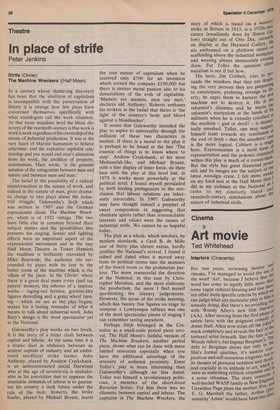Cinema
Art movie
Ted Whitehead
Interiors (Cinecenta) For two years, reviewing theatre of cinema, I've managed to avoid the use,,,e the word 'Art', because I believe that word has come to signify little more th'7, some vague cultural blessing and that ther:we are other more specific criteria by which can judge what any particular play or actually doing. But there's no avoiding with Woody Allen's new film litteri°"f (AA). After moving from the first plbajse °Of satiric farce with the poignant cornea ,s Annie Hall, Allen now strips off the jokerke mask completely and reveals the face of lu not tortured artist beneath. But the face iso e Woody Allen's, but Ingmar Bergman's. the debt to Bergman shows not only in 'iv film's formal qualities, it's austere position and self-conscious elegance, buttb, its themes of personal isolation and det is and crucially in its attitude to art, valic'd is seen as something refined, exquisite ari a a sense inhuman. The story coneeciLs well-heeled WASP family in New Eng'—oil Geraldine Page plays the mother, E. G. Marshall the father, Arthur ktvi.. sumably 'Adam' would have been too ov °Lus — symbolism is never very far away "ere). Arthur is a quiet, decent, responsible s°11 of than while Eve is the perfect wife and mother — a little tense and introverted, Perhaps, but then she's an artist. If Arthur Provides the loot, she provides the aesthetic sense that makes their home a model of gracious affluence. They have three daughters, Renata (Diane Keaton), Flyn (Kristin Griffith) and ineY (Marybeth Hurt) and look like the classic happy family. When the daughters have grown up and gone their separate Ways, Arthur tells Eve that he would like a trial separation. It's a polite but firm prop osal, made over the breakfast table. Eve is shattered, the daughters astounded, and their reactions illuminate both their indi vidual personalities and the relationships Within the family group. The most sympathetic, or at least understanding, reaction comes from Diane Keaton, a brilliant poet who has her own exPertence of marital frustration: her husband (Richard Jordan) is a novelist racked °Y the knowledge that his literary talent is inferior to hers, constantly demanding her suPPort and encouragement and then ,denouncing it as insincere. She's also uneas 4 aware that he fancies her sister, FlYn, a sexy television actress who spends most of her time on the far coast and is least involved in the family drama, being rather inure preoccupied with the fact that the work she is doing is junk and that she is never considered if a good role comes along. The most hostile reaction comes from key, Daddy's blue-eyed girl in childhood, and apparently the most promising of the sisters: her problem is that she has all the signs of the artistic temperament but no Particular artistic motivation — she tries Writing, sketching and photography, without success and with increasing bitterness, until she is finally reduced to wondering Whether motherhood might not be a substitute for artistic creativity. There's a scene of painful, low-key intensi.tY when the father visits the mother for a nial chat in her new apartment — beaut'luny decorated and furnished, of course — and, after he leaves, she systematically seals tat! the windows and doors with tape and lies to gas herself. But she's discovered, the statighters rally round, and she survives to niggle along until Arthur provokes the next crisis by announcing that he wants their divorce finalised so that he can marry again. __The contrast between Eve and the new Wife, Pearl (Maureen Stapleton), is at the :Sart of the film, Pearl is described by Joey ,,n_a 'vulgarian', and I suppose she is in the 7_use that her responses are simple and "" mplicated, more sensual than cerebral, aainkdi taste to her is a function of the tongue and "t of the sensibility. She likes eating she drinking, and music and dancing, and v.„.!_rws the boys with card tricks — in other tts7-"lx, she's a lot of fun, and that's some Arthur has had very little of. If for mulur she represents an escape from bourgeois respectability, for Woody Allen she seems to offer an alternative to the neurotic, self-conscious, obsessive figure of the artist — or at least of his type of artist.
Her role as life-force is symbolised in the melodramatic finale, when Eve commits suicide by marching into the ocean. (The ocean has been pounding away promisingly for some time.) Joey goes in after her, is almost drowned but is saved when Pearl applies the kiss of life.
If the manner is too derivative; Allen has also emulated Bergman in drawing superb performances from his cast, who are not only convincing but also suggest the complexity of unspoken and perhaps unspeakable feelings. And if the clouds that gather over the Long Island house seem peculiarly Swedish, the theme of the tension between the vulgar and the fine is authentically American and authentically Allen, now in the costume of tragedy.















































 Previous page
Previous page